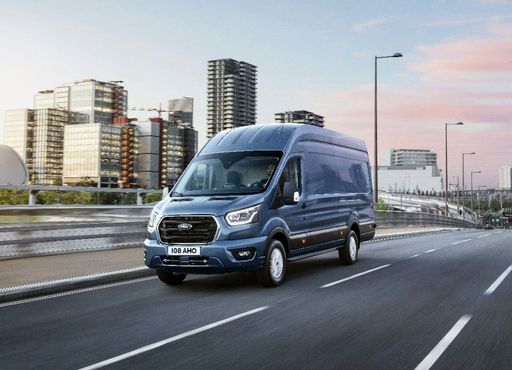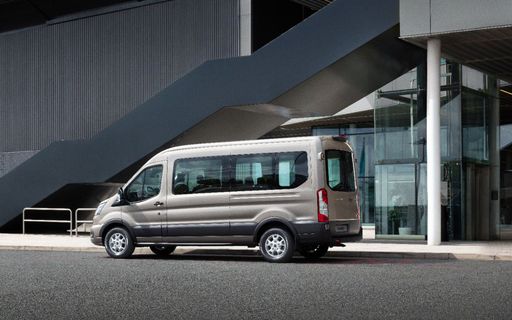Ford Transit Bus vs Renault Trafic Bus – Which one offers the better deal?
Costs and Efficiency:
Price and efficiency are key factors when choosing a car – and this is often where the real differences emerge.
Renault Trafic Bus has a noticeable advantage in terms of price – it starts at 38200 £, while the Ford Transit Bus costs 50500 £. That’s a price difference of around 12261 £.
Fuel consumption also shows a difference: Renault Trafic Bus manages with 6.70 L and is therefore significantly more efficient than the Ford Transit Bus with 9.40 L. The difference is about 2.70 L per 100 km.
Engine and Performance:
Power, torque and acceleration are the classic benchmarks for car enthusiasts – and here, some clear differences start to show.
When it comes to engine power, the Renault Trafic Bus has a somewhat edge – offering 170 HP compared to 150 HP. That’s roughly 20 HP more horsepower.
There’s also a difference in torque: Ford Transit Bus pulls hardly perceptible stronger with 390 Nm compared to 380 Nm. That’s about 10 Nm difference.
Space and Everyday Use:
Whether family car or daily driver – which one offers more room, flexibility and comfort?
Both vehicles offer seating for 9 people.
In curb weight, Renault Trafic Bus is a bit lighter – 2031 kg compared to 2338 kg. The difference is around 307 kg.
When it comes to payload, Ford Transit Bus a bit takes the win – 1162 kg compared to 982 kg. That’s a difference of about 180 kg.
Who comes out on top?
Overall, the Renault Trafic Bus shows itself to be outperforms in nearly all aspects and secures the title of DriveDuel Champion.
It convinces with the more balanced overall package and proves to be the more versatile choice for everyday use.
Costs and Consumption
View detailed analysis
Engine and Performance
View detailed analysis
Dimensions and Body
View detailed analysis

Renault Trafic Bus
Ford Transit Bus
The Ford Transit Bus is renowned for its robust performance and spacious interior, making it an ideal choice for both commercial and personal use. With its efficient handling and modern design, it effortlessly combines practicality with comfort. Its adaptability and versatility ensure it meets the demands of various driving needs, from urban transport to long-distance journeys.
details @ Ford Motor Company / Ford Media Center
@ Ford Motor Company / Ford Media Center
 @ Ford Motor Company / Ford Media Center
@ Ford Motor Company / Ford Media Center
 @ Ford Motor Company / Ford Media Center
@ Ford Motor Company / Ford Media Center
Renault Trafic Bus
The Renault Trafic is a practical people-carrier that prefers sensible space and smart flexibility to showroom gloss, making it a top pick for families, shuttle operators or anyone ferrying a crowd without fuss. It’s comfortable, economical in everyday running and blessedly uncomplicated — not the most glamorous vehicle, but brilliantly dependable when you need it to be.
details
 @ Ford Motor Company / Ford Media Center
@ Ford Motor Company / Ford Media Center
|
|
|
|
|
Costs and Consumption |
|
|---|---|
|
Price
50500 - 52900 £
|
Price
38200 - 54400 £
|
|
Consumption L/100km
9.4 - 9.5 L
|
Consumption L/100km
6.7 - 7.2 L
|
|
Consumption kWh/100km
-
|
Consumption kWh/100km
-
|
|
Electric Range
-
|
Electric Range
-
|
|
Battery Capacity
-
|
Battery Capacity
-
|
|
co2
245 - 248 g/km
|
co2
175 - 189 g/km
|
|
Fuel tank capacity
70 L
|
Fuel tank capacity
80 L
|
Dimensions and Body |
|
|---|---|
|
Body Type
Bus
|
Body Type
Bus
|
|
Seats
9
|
Seats
8 - 9
|
|
Doors
4
|
Doors
4
|
|
Curb weight
2338 - 2385 kg
|
Curb weight
2031 - 2352 kg
|
|
Trunk capacity
0 L
|
Trunk capacity
-
|
|
Length
5531 - 5981 mm
|
Length
5080 - 5480 mm
|
|
Width
2059 mm
|
Width
1956 mm
|
|
Height
2530 - 2533 mm
|
Height
1973 - 1974 mm
|
|
Max trunk capacity
-
|
Max trunk capacity
3200 - 4000 L
|
|
Payload
1115 - 1162 kg
|
Payload
718 - 982 kg
|
Engine and Performance |
|
|---|---|
|
Engine Type
Diesel
|
Engine Type
Diesel
|
|
Transmission
Automatic
|
Transmission
Manuel, Automatic
|
|
Transmission Detail
Automatic Gearbox
|
Transmission Detail
Manual Gearbox, Automatic Gearbox
|
|
Drive Type
Front-Wheel Drive
|
Drive Type
Front-Wheel Drive
|
|
Power HP
130 - 150 HP
|
Power HP
110 - 170 HP
|
|
Acceleration 0-100km/h
-
|
Acceleration 0-100km/h
10.6 - 16.5 s
|
|
Max Speed
-
|
Max Speed
161 - 180 km/h
|
|
Torque
360 - 390 Nm
|
Torque
300 - 380 Nm
|
|
Number of Cylinders
4
|
Number of Cylinders
4
|
|
Power kW
96 - 110 kW
|
Power kW
81 - 125 kW
|
|
Engine capacity
1996 cm3
|
Engine capacity
1997 cm3
|
General |
|
|---|---|
|
Model Year
2024
|
Model Year
2023 - 2025
|
|
CO2 Efficiency Class
G
|
CO2 Efficiency Class
G, F
|
|
Brand
Ford
|
Brand
Renault
|
What drivetrain options does the Ford Transit Bus have?
Available configurations include Front-Wheel Drive.
The prices and data displayed are estimates based on German list prices and may vary by country. This information is not legally binding.
